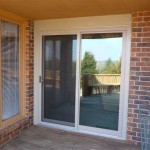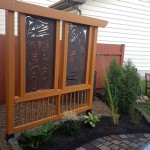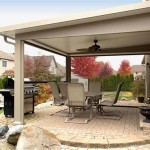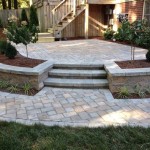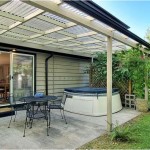Outdoor Flagstone Patio Ideas For Beginners in Atlanta, Georgia, USA
Creating an outdoor flagstone patio can significantly enhance the aesthetic appeal and functionality of a property in Atlanta, Georgia. Flagstone, a natural sedimentary rock, offers a durable, visually appealing, and relatively low-maintenance surface for outdoor living spaces. This article provides an overview of outdoor flagstone patio ideas specifically tailored for beginners in the Atlanta area, considering the local climate, available resources, and common landscaping practices.
Atlanta's climate, characterized by hot, humid summers and mild winters, necessitates careful consideration of material selection and installation techniques for outdoor patios. Flagstone is generally well-suited for this climate, offering good drainage and resistance to temperature fluctuations. However, proper installation is crucial to prevent issues such as shifting, cracking, and weed growth.
Understanding Flagstone Varieties and Selection
Flagstone is available in a variety of colors, textures, and sizes, each offering a unique aesthetic and level of durability. Common types of flagstone suitable for patios in Atlanta include Pennsylvania Bluestone, Arizona Flagstone, and Tennessee Crab Orchard. Pennsylvania Bluestone is known for its consistent color and smooth surface, while Arizona Flagstone offers a wider range of colors and textures. Tennessee Crab Orchard is characterized by its earthy tones and rugged appearance. The choice of flagstone should be based on personal preference, budget, and the overall design of the outdoor space.
When selecting flagstone, it is essential to consider the thickness of the stones. For patios intended for foot traffic only, flagstone that is 1 to 2 inches thick is typically sufficient. For patios that will support heavier items such as furniture or grills, thicker stones (2 to 3 inches) are recommended. It is also important to inspect the stones for any cracks or defects that could compromise their structural integrity.
Local stone suppliers in Atlanta offer a wide selection of flagstone, and it is advisable to visit these suppliers to view the available options in person and obtain expert advice on the most suitable types for a specific project. Reputable suppliers can also provide guidance on the quantity of flagstone required based on the patio's dimensions and the desired spacing between the stones.
Planning and Preparation for Flagstone Patio Installation
Before beginning the installation process, careful planning and preparation are essential. This includes determining the size and shape of the patio, as well as marking the area with stakes and string. It is also important to consider the existing landscaping and drainage patterns to ensure that the patio will integrate seamlessly with the surrounding environment. Accurate measurements are crucial for calculating the amount of flagstone, base material, and other supplies needed.
Excavation is the next step in the preparation process. The area designated for the patio should be excavated to a depth of approximately 6 to 8 inches. This depth allows for a 4-inch base of compacted gravel and a 2-inch layer of sand or stone dust. The excavated area should be level and compacted using a plate compactor to provide a stable foundation for the flagstone.
Proper drainage is essential for preventing water accumulation and potential damage to the patio. The patio should be sloped slightly (approximately ¼ inch per foot) away from the house or other structures to allow for water runoff. It may also be necessary to install drainage systems, such as French drains or perforated pipes, to manage subsurface water. Consult with a landscaping professional to determine the best drainage solution for a particular property.
Installing the Flagstone Patio
Once the excavation and base preparation are complete, the flagstone can be laid. There are two primary methods for installing flagstone: dry-laid and wet-laid. Dry-laid patios are more common for beginners due to their simplicity and lower cost. In this method, the flagstones are placed directly on a bed of sand or stone dust without the use of mortar. Wet-laid patios, on the other hand, involve setting the flagstones in a mortar bed, which provides a more permanent and stable surface. However, wet-laid patios require more skill and experience to install correctly.
For dry-laid patios, start by spreading a 2-inch layer of sand or stone dust over the compacted gravel base. Use a level to ensure that the sand layer is even and consistent. Next, carefully place the flagstones on the sand bed, leaving gaps of approximately 1 to 3 inches between the stones. The size and shape of the gaps can be varied to create a more natural and informal look.
After the flagstones are in place, use a rubber mallet to gently tap them into the sand bed, ensuring that they are level and stable. The gaps between the stones can be filled with polymeric sand, pea gravel, or groundcover plants. Polymeric sand is a popular choice because it hardens when wet, preventing weed growth and erosion. Pea gravel provides a more natural look and allows for better drainage. Groundcover plants, such as creeping thyme or sedum, can add visual interest and soften the edges of the patio.
For wet-laid patios, a concrete slab is typically poured first, followed by a mortar bed. The flagstones are then set into the mortar bed and leveled. This method requires careful attention to detail and precise measurements to ensure that the patio is level and the stones are properly aligned. Grouting is then done between the stones, and the entire surface is cleaned. This method provides a much more permanent and durable patio surface but is often beyond the scope of a beginner's DIY project.
Designing with Flagstone: Aesthetic Considerations
Flagstone offers a wide range of design possibilities for outdoor patios. The natural variations in color and texture can be used to create a unique and visually appealing space. Consider the overall design aesthetic of the property when selecting flagstone and planning the layout of the patio. A formal garden may benefit from the clean lines and consistent color of Pennsylvania Bluestone, while a more rustic setting may be better suited to the earthy tones and irregular shapes of Arizona Flagstone or Tennessee Crab Orchard.
The shape of the patio can also have a significant impact on its overall appearance. A rectangular patio may be a good choice for a formal space, while a circular or free-form patio can create a more informal and inviting atmosphere. Consider the existing landscaping and architectural features of the property when determining the shape of the patio. Incorporating curved edges and flowing lines can help the patio blend seamlessly with the surrounding environment.
The gaps between the flagstones can also be used to create visual interest. Varying the size and shape of the gaps can add character and texture to the patio. Groundcover plants, such as creeping thyme or sedum, can be planted in the gaps to create a lush and natural look. Alternatively, the gaps can be filled with pea gravel or polymeric sand to create a more uniform and low-maintenance surface.
Maintenance and Care of Flagstone Patios in Atlanta's Climate
Flagstone patios are relatively low-maintenance, but regular care is essential to keep them looking their best. In Atlanta's humid climate, algae and moss can grow on flagstone surfaces, particularly in shaded areas. Regular cleaning with a garden hose and a stiff brush can help to remove these growths. For more stubborn stains, a mild detergent or a specialized stone cleaner can be used.
Weed growth is another common issue with flagstone patios, particularly those that are dry-laid. Polymeric sand can help to prevent weed growth, but it is still necessary to inspect the gaps between the stones regularly and remove any weeds that do sprout. Herbicides can be used to kill weeds, but it is important to choose a product that is safe for use around plants and pets.
Over time, the sand or stone dust between the flagstones may erode, particularly in areas with heavy foot traffic. It is important to periodically replenish the sand or stone dust to maintain the stability of the patio. This can be done by sweeping the material into the gaps between the stones and tamping it down with a rubber mallet.
Sealing the flagstone can help to protect it from staining and erosion. A penetrating sealer will help to repel water and prevent stains from penetrating the surface of the stone. A topical sealer will create a protective coating on the surface of the stone, which can enhance its color and texture. However, it is important to choose a sealer that is specifically designed for flagstone and to follow the manufacturer's instructions carefully.
Cost Considerations for Atlanta Flagstone Patios
The cost of a flagstone patio in Atlanta can vary depending on several factors, including the type of flagstone selected, the size of the patio, and the installation method. Flagstone prices can range from $5 to $15 per square foot, depending on the type and quality of the stone. Labor costs can also vary depending on the complexity of the project and the experience of the contractor. It is advisable to obtain multiple quotes from different contractors to compare prices and services before making a final decision.
DIY installation can significantly reduce the cost of a flagstone patio, but it is important to factor in the cost of tools and materials, as well as the time and effort required to complete the project. Beginners may want to start with a small and simple patio design to minimize the risk of costly mistakes.
The cost of base materials, such as gravel and sand, should also be considered. These materials can add significantly to the overall cost of the project, particularly for larger patios. It is important to purchase high-quality base materials to ensure the stability and longevity of the patio.

7 Atlanta Backyards That Will Make You Jealous Marygrove Awnings

Flagstone Patio Ideas To Elevate Your Outdoor Space

25 Great Stone Patio Ideas

25 Great Stone Patio Ideas

7 Backyard Patio Ideas To Revamp Your Outdoor Sanctuary Shrubhub

Atlanta Porch Patio Updated July 2025 56 Photos 15 Reviews 1785 Roswell Rd Marietta Georgia Decks Railing Phone Number Yelp

8 Ways To Use Flagstone In Your Landscaping Lawnstarter

25 Great Stone Patio Ideas

Flagstone Patio Ideas To Elevate Your Outdoor Space

Atlanta Patios Top Designs
Related Posts

